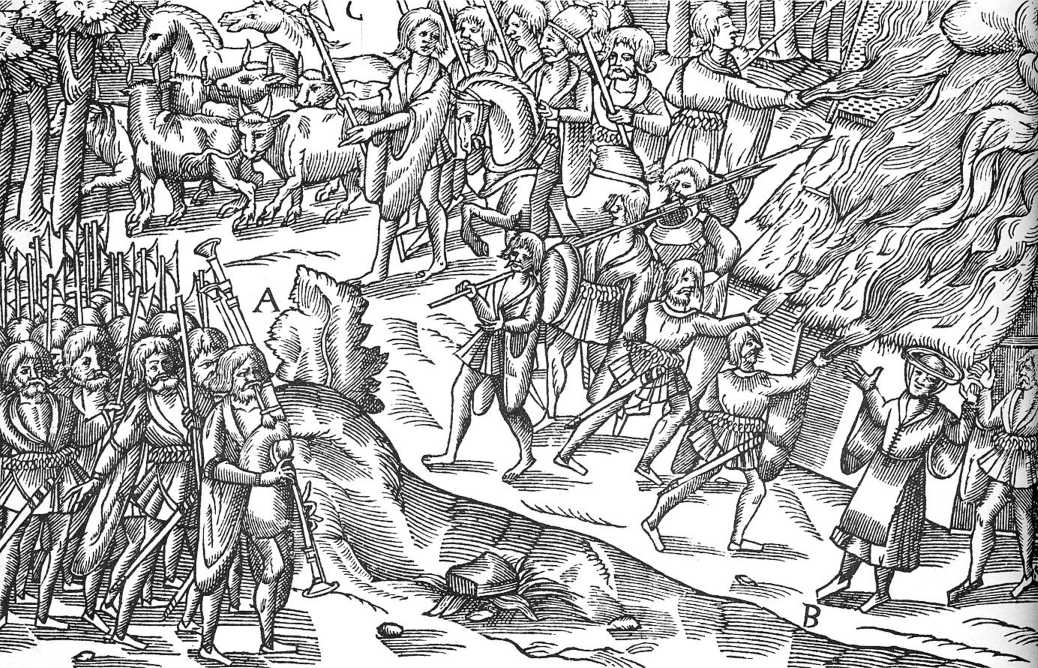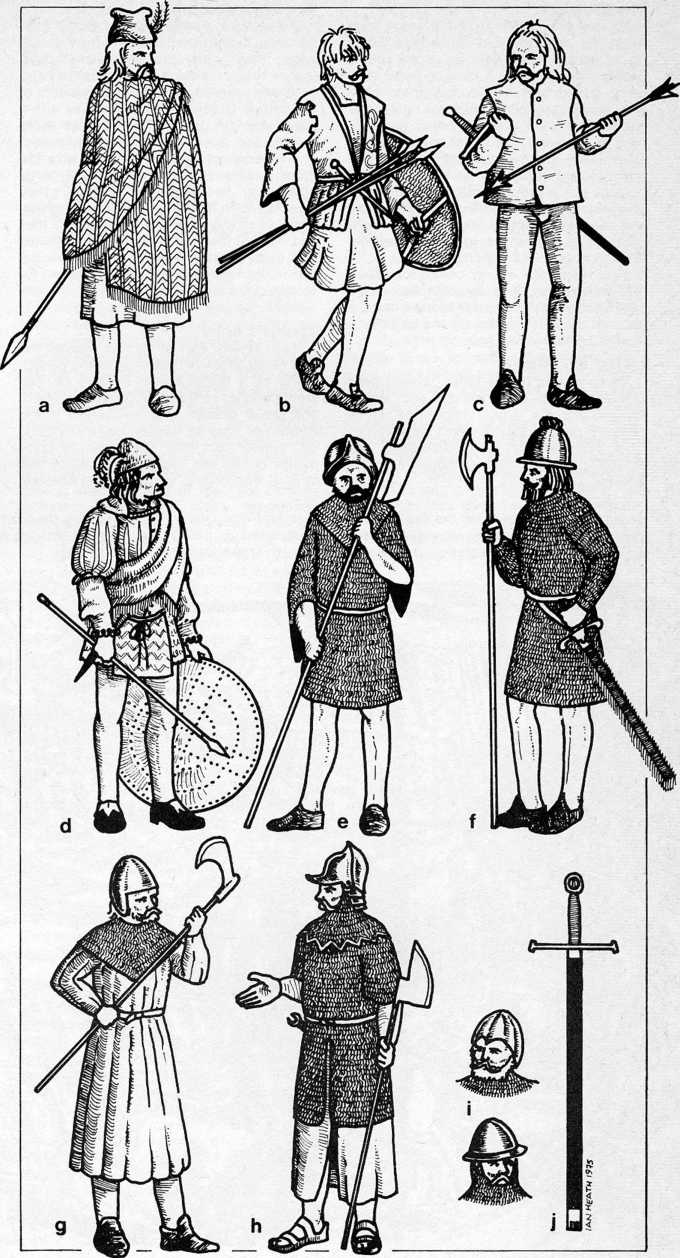The cross of St Patrick was not apparently considered as a symbol of Ireland at the time. Two ’national’ flags which may have been used in the 16th Century are a blue flag with three gold crowns, and the traditional Irish harp in gold, probably then on a blue ground.
In the ’Desmond Rebellion’ (1579-83) the rebels had the Pope’s banner, presumably red with the crossed keys of St Peter in silver and gold beneath the triple crown of the Papacy.
Tyrone had recognised Philip II of Spain as King of Ireland, and had the support of Spanish troops, and it appears that some of his units carried ’Spanish Flags’ of white bearing the red diagonal cross raguly of Burgundy, but they had other flags too.
The 17th Century Confederates seem to have been the first to use a green flag with a golden harp but also employed flags with the ’Irish Cross’ shown.
This print from John Derrick's The Image of Ireland (1581) shows Ulster Kern indulging in their usuai raiding. The particular type of jacket worn, with pleated ‘frilT, is probably an Ulster variation. At lower left the men with long axes are probably bonnachts. Note the bagpiper (British Library).

A Irishman in mantle. Cap is of a type worn by Irish irregulars in Europe, b Kern with 'Skean', shield and darts. Tunic is simpler than the Ulster version shown in Derrick's prints. Note type of surcoat. c Kern, early 17th Century. He wears a very short, loose coat of blue and tight hose (pinkish-red seems to be the usual colour). He holds his sword under his right arm (the Irish are often shown holding sheathed swords, rather than having them slung from belts). In his left hand is a javelin, in this case having actual flights, like a modern dart. He wears dark leather brogues, d Irish chieftain, 17th Century. He holds a black, gold mounted javelin in his right hand, and a shield (a large oval affair, covered in red leather and decorated with studs) in his left. His conical cap is of tooled red leather. He wears a slashed doublet with half sleeves, the traditional fringed cloak and red hose, and a decorated ‘Erse apron', e and 1 A pair of Gallowgiasses, both from sketches by G. A. Hayes McCoy, ‘f has a somewhat Scandinavian look and not surprisingly comes from a charter granted to Dublin in 1583. He has a typical sword and scabbard, tall helmet with small crest (?), and long-handled axe. 'e' comes from a map of 1567. Note baggy sleeves, mail cape, typically 15th Century bascinet, and seven-foot Lochaber axe. Both are barelegged, and could have been barefooted too. g Gallowgiass in 'cotun', mail cape and helmet, h Gallowgiass in mail cape and skirt and cavalry-style helmet. Note different shape of axe (based on a Diirer drawing), i Two alternative Gallowgiass helmets. The upper drawing depicts a 15th Century padded type, j Typical Irish 16th Century sword. Note ring at base of hilt with tang passing through it, and square-ended scabbard. Irish swords of this period were usually straight, and large. The accompanying Derrick prints show alternative scabbard types, especially those with a dagger strapped to the outside of the scabbard.
Flags shown in a print of the Irish force at the battle of Erne Fords in 1593. Infantry flag on left, cavalry on right. Colours not known. The cavalry flag may be an ‘Irish Cross'. Something similar in red on white was carried by the 17th Century Catholic Confederates.

The cavalry
A small proportion of the average Irish force, the cavalry would normally be made up of gentry. They were equipped with a helmet with a strange turned-up nasal, mail shirt, sword and shield, but their chief weapon was a longish light spear held in the middle and used overarm either for stabbing or throwing, not couched as a lance. One reason for this was that the Irish, like their ancient forebears, still used neither stirrups nor a proper saddle (though their checked, pillow-like saddles may have had a wooden tree); another was that their light cobs could not stand up to the heavier English horses in a full charge.
They were thus mainly useful for scouting, skirmishing, or pursuit. In the earlier 16th Century the Irish seem to have had the unusual habit of drawing up the cavalry on the left of their battle line.




 World History
World History









